Scientists at DPI are investigating the effects of deficit irrigation on yield, quality and composition of apples Royal Gala and Pink Lady™ as part of the APAL-funded PIPS (Production, Irrigation, Pests and Soil) project.
Fruit colour, firmness, sweetness, maturity and antioxidant content are being measured in response to both low and high irrigation treatments.
In this article results on yield and selected aspects of fruit quality of Royal Gala from the 2011–12 season are reported.
Estimating fruit ripeness
The industry currently lacks an affordable, objective non-destructive means of estimating fruit ripeness.
This study therefore sought to test the use of a DA meter as a practical field indicator of the physiological maturity of the fruit.
The DA-Meter non-destructively measures chlorophyll degradation in the fruit flesh (change in colour from green to yellow), and appeals as a potential practical gauge for fruit ripeness.
Experimental methods
Site
The experiment was established in spring 2008 in a commercial Royal Gala (on M106) apple orchard in Shepparton East.
Trees were planted in 1995 (spaced at 2.5 m along rows and 5 m between rows) and trained as central leader.
Plots included 15 trees. Measurements were made on 10 trees/plot. Pests, diseases and weeds were managed by the grower and were the same for all treatments.
Harvests were in late January and early February 2012.
Treatments
Irrigation treatments were 38, 50, 74, 100 and 162 percent of standard grower irrigation application.
Trees were micro-irrigated using turbulent flow jet stream sprayers located midway between trees along the tree-line approximately 0.4 m above the soil surface.
To achieve the desired levels of irrigation, emitters with different flow rates were installed.
Irrigation run time was the same for all treatments.
Water inputs were applied and managed by the owner of the orchard.
Since late 2009 overhead irrigation to increase colour and reduce heat damage to fruit was installed by the grower and switched on at need when air temperature exceeded approximately 32C.
Yield
Fruit was harvested on 26 January and 7 February 2012.
Total yield (kg fresh weight) and fruit number were determined by counting and weighing all fruit from each plot.
Fruit that was small (< 100 g) or physically damaged from sunburn, cracking or pests and disease was separated, counted and weighed. Average fruit weight (gram fresh weight) was calculated from fresh weight yield per plot and fruit number per plot.
Fruit maturity
Fruit maturity was measured weekly by the DA-Meter, starting in early January.
Fruit ethylene production was measured on two occasions by gas chromatography.
Fruit sweetness
Fruit sweetness (°Brix) was measured at harvest on a sample of 20 fruit per tree with a pocket refractometer.
Results
Irrigation inputs
The grower applied 4.5 ML/ha (i.e. 451 mm) of irrigation to the 100% treatment while approximately 6.7 ML/ha (i.e. 669 mm) was applied to the 162% treatment (Table 1).
Rainfall was 324 mm with significant rainfall events post harvest in late February and March (Figure. 1).
Reference crop evapotranspiration (ETo)— equivalent to water use of grass—was 781 mm and our estimate of apple orchard water use (WU) was 549 mm.
Irrigation by the grower (i.e. 100% treatment) exceeded WU during December and January (Figure 1). Irrigation was cut-back after harvest and there was a clear divergence between WU and irrigation.
Yield
There was no significant difference in yield due to irrigation treatments.
Similarly, treatments had no significant impact on fruit number.
By contrast, fruit size was significantly reduced by deficit irrigation (Figure 2).
Fruit maturity
DA-Meter measurements showed a broad correlation with ethylene produced by the fruit (Figure 3).
We were therefore able to use the DA meter data to make field estimates of the physiological maturity of the fruit: DA values were grouped in four maturity classes to guide seasonal progression in harvest and storage potential (Table 2).
More research is necessary to identify the necessary storage length for each class.
Irrigation rates < 100 % had a significant impact on fruit maturity and consequently fruit storability and the subsequent market that could be targeted (Figure 4) as reducing water to trees delayed fruit ripening.
Fruit from the smallest irrigation volume (38%) were the least mature at each sampling date and had the greatest storage potential.
The highest maturity was measured in 100% and 162% irrigation treatments at both harvest dates while fruit from 50% and 74% irrigation were in the middle.
Harvest dates were based on fruit colour, as is the normal practice for growers. Harvested according to this traditional criteria, therefore, resulted in most of the fruit being suitable for short-term storage at the first harvest but fruit was over-ripe at the second harvest and only suitable for immediate consumption (Figure 4).
In this case it can be concluded that fruit were harvested too late for storage and use of the DA meter early in the ripening phase can more accurately predict optimum harvest date.
Fruit sweetness
Deficit irrigation significantly increased fruit sweetness confirming the trend noticed in previous years.
There was a high inverse correlation between volume of water delivered to the trees and fruit sweetness, with 38% irrigation volume having the highest °Brix value and 162% the lowest (Figure 5).
Conclusion
Although irrigating to 74% of estimated crop water requirement did not affect marketable yield in 2011–12, reduced irrigation decreased fruit size, increased fruit sweetness, and delayed maturity.
Growers must exercise great care in the application of orchard practices aimed at optimising yield and quality outcomes.
The ability to monitor fruit ripening in the field could help growers to optimise harvest time.
See the full article with graphs and tables in the May-June 2012 issue of Tree Fruit magazine






















